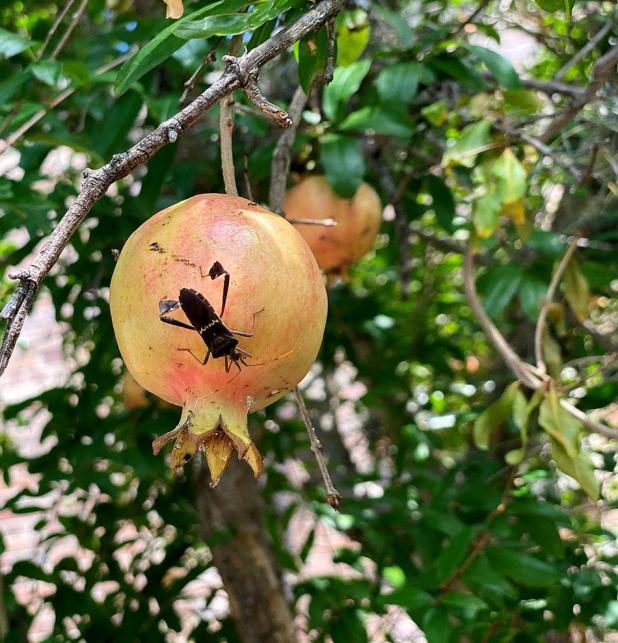
Stink bugs are a common problem on pomegranates. Control them with organic pesticide soaps and oils, or use a shop vacuum to remove them from fruit.
—LSU AgCenter/Heather Kirk-Ballard
Get It Growing: Pomegranates can grow in the Gulf South
Pomegranates are unique fruits whose origins have been traced to Persia. Native to Iran through northern India, they are grown around the world today. The fruit is considered sacred and is believed to provide abundance, fertility and even luck. Fortunately, we can grow the fruit in Louisiana and throughout the Gulf South.
Pomegranate (Punica granatum) is a small, deciduous shrub that is often trained as a small tree with a single trunk. The plants can grow anywhere from 10 to 30 feet in height. The flowers are produced in late spring and are a beautiful orange-red color. Fruits occur in late summer into the fall.
The unique fruit has a leathery rind in colors including yellow, pink, red and sometimes purple, depending on the cultivar. The fruit is comprised of hundreds of seeds surrounded by juicy pigments, each contained within a seed coat called an aril — the edible portion of the fruit. The juice within the aril varies from light pink to dark red but can also be clear.
Pomegranates prefer cool winters and hot, dry summers, with most cultivars being hardy down to 12 degrees Fahrenheit. The majority of pomegranate varieties do not require winter chill hours, but a few cold-hardy cultivars require 250 to 450 chilling hours.
Plant in full to partial sun for best fruit production. Eight hours of full sun is recommended.
Pomegranates are extremely heat and drought tolerant and grow in a wide range of soils, although good drainage is imperative. Pomegranates should be planted on a raised bed at least 4-feet wide and six to 12 inches in height.
Plants are best at temperatures above 85 degrees for approximately 120 days a year for the best fruit production. Supplemental irrigation is necessary during tree establishment and for fruit production during prolonged periods of drought.
Light pruning is typically done in the winter months prior to bud break and is used to open up the canopy to a vase-shaped tree to improve airflow and sunlight penetration. Suckers should be removed regularly in mid-summer.
The suggested fertilizer rate is 1 ounce of 10-10-10 per foot of bush height three times a year (early spring, late spring and summer) applied evenly in a circle about 18 inches in diameter with the plant in the center. Continue to increase the diameter of the circle and the rate as the plants grow — up to a maximum of 8 ounces per application when the plants are 8 feet tall.
In general, the fruit and trees are considered reasonably disease-tolerant. Stink bugs can be a problem, and these can be controlled with BT pesticides, organic sprays, soaps and plant oils such as horticultural and neem oils.
Bloom begins in April and continues through to June either in a continuous manner or in a few flushes. The trees produce fruit three to four years after planting. Pomegranates are self fruitful. Insects and hummingbirds pollinate them.
Fruit ripens in the fall about six months after bloom. Leave the fruit to ripen on the tree because it will not continue to ripen after being picked. You can tell that fruit is ready when it makes a metallic sound when lightly tapped. Harvest by cutting fruit off the tree — don’t pull. Pomegranates can be stored at 40 to 45 degrees with a relative humidity of 85% for up to three months.
Pomegranates are commonly eaten fresh. Some of the new varieties have soft seeds that can be eaten with the fleshy pulp. The fruit can be juiced and is a popular drink for its antioxidant health benefits.
The most popular variety of pomegranates for Louisiana is Wonderful. This plant makes a 15-foot shrub. A few ornamental varieties of pomegranates have double-flower forms.
Trees can be found at local retail garden centers or propagated from cuttings. Trees will reach maturity in five to seven years and can live for hundreds of years.
